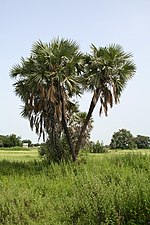Hyphaene thebaica
Stem to 20 m tall, although reported of 4-5 m (Leeuwenberg 7588-WAG) and to 15-20 cm in diameter, frequently solitary or apparently forking below ground and producing 2 or more stems of more or less the same size; stems conspicuously branched; leaves 8-12; fruits ovoids, 4-6 cm long and 4-5 cm wide, brown to dark brown when ripe.
The distribution of H. thebaica is rather complex due to the fact that the species is economically important and has traditionally been planted by human populations. It has been reported for the Sahel region (Burkina Faso, Mali, and Niger) and also in tropical West African countries (Côte d’Ivoire, Ghana and Senegal). This palm is also present in Cameroon, Somalia and Ethiopia (Tuley, 1995; Arbonier, 2009, Hedberg, et al., 2009). Its presence in Angola needs to be confirmed (Baker, 2008).
This is a palm of arid, desert climates, associated with the heavy soils of drainage lines and alluvial flats with high water tables.



